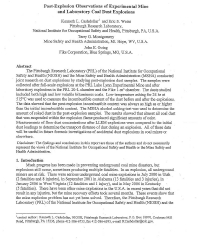 |
The Pittsburgh Research Laboratory (PRL) of the National Institute for Occupational Safety and Health (NIOSH) and the Mine Safety and Health Administration (MSHA) conducted joint research on dust explosions by studying post-explosion dust samples. The samples were collected after full-scale explosions at the PRL Lake Lynn Experimental Mine and after laboratory explosions in the PRL 20-L chamber and the Fike 1 -m3 chamber. The dusts studied included both high and low volatile bituminous coals. Low temperature ashing for 24 hr at 5 15°C was used to measure the incombustible content of the dust before and after the explosions. The data showed that the post-explosion incombustible content was always as high as or higher than the initial incombustible content. The MSHA alcohol coking test -was used to determine the amount of coked dust in the post-explosion samples. The results showed that almost all coal dust that was suspended within the explosion flame produced significant amounts of coke. Measurements of floor dust concentrations after LLEM explosions were compared to the initial dust loadings to determine the transport distance of dust during an explosion. All of these data will be useful in future forensic investigations of accidental dust explosions in coal mines or elsewhere.
| Author(s): | Cashdollar-KL, Weiss-ES, Montgomery-TG, Going-JE |
| Reference: | Proceedings of the Sixth International Symposium on Hazards, Prevention, and Mitigation of Industrial Explosions (Halifax, NS, Canada, Aug. 27 - Sept. 1, 2006), Halifax, Canada: Dalhousie University, 2006 Aug; 2:662-675 |
peobo (PDF, 1164 KB) (image based PDF - searchable with Adobe Reader 7)
